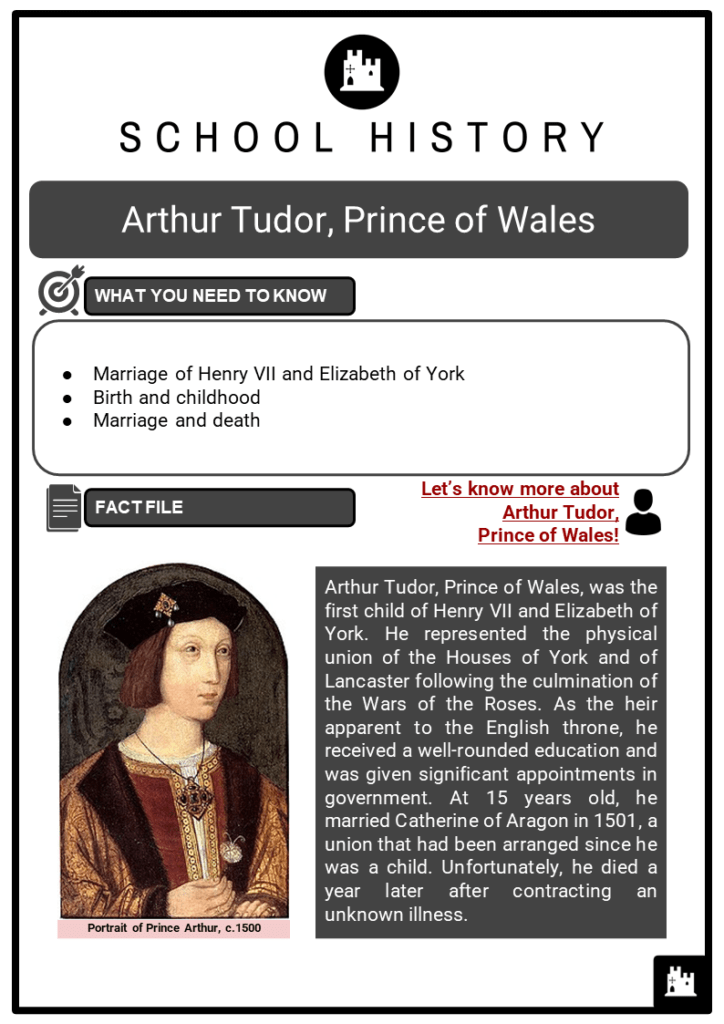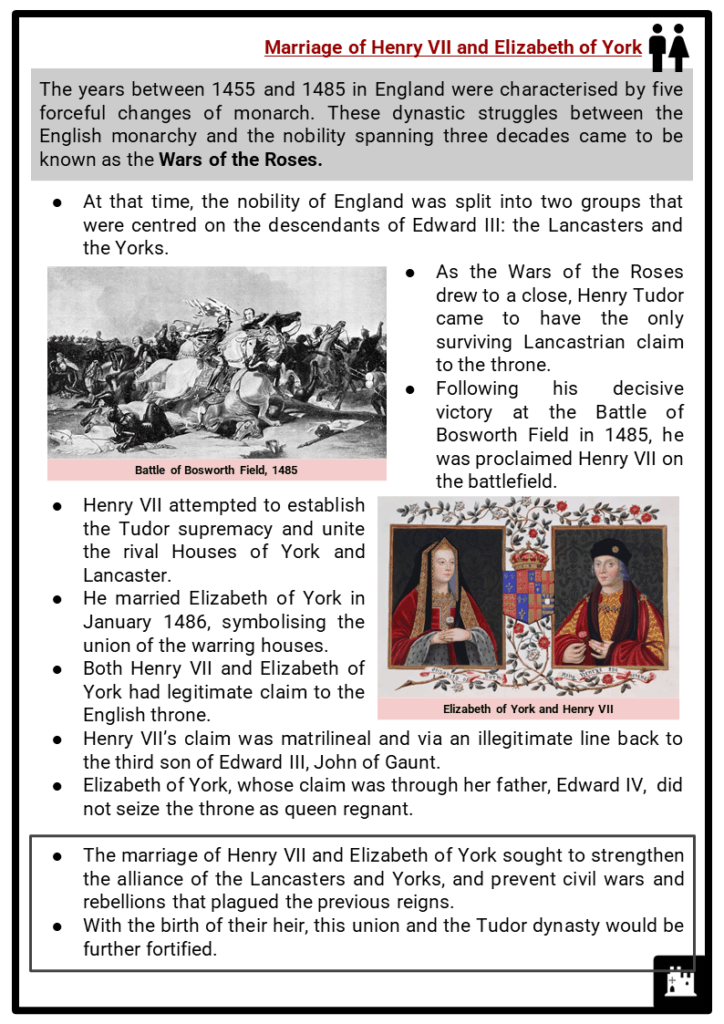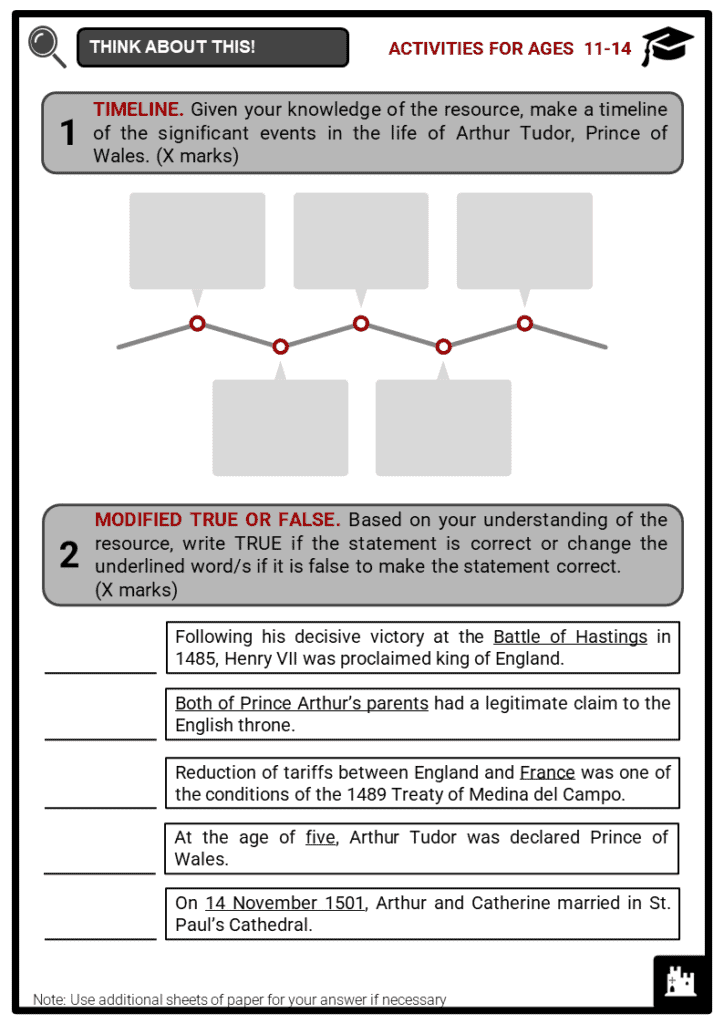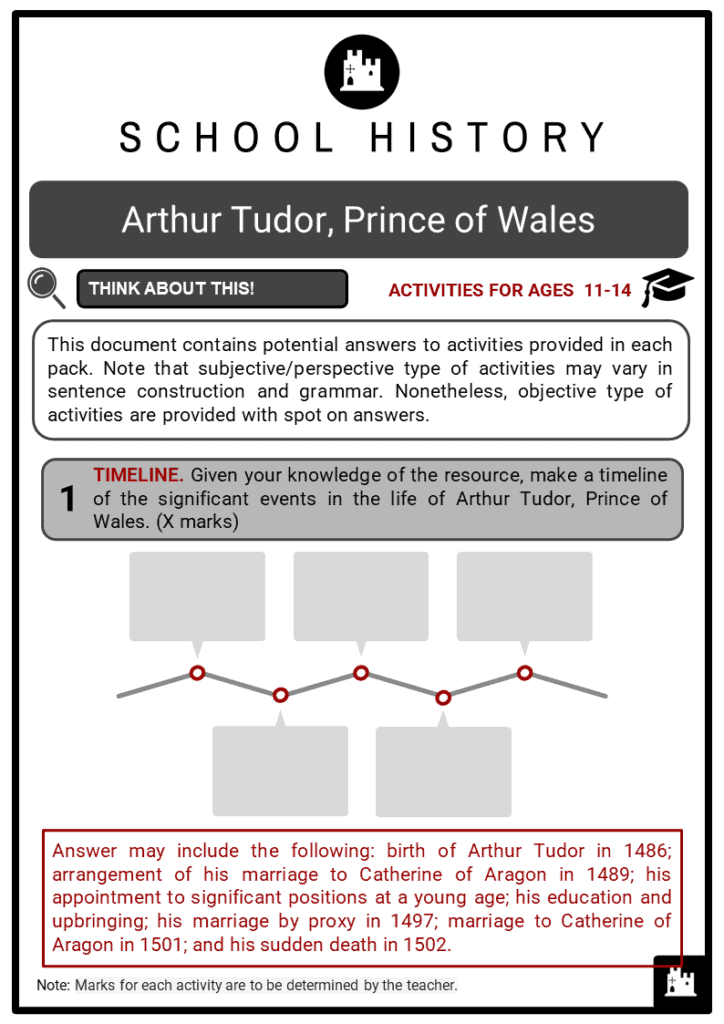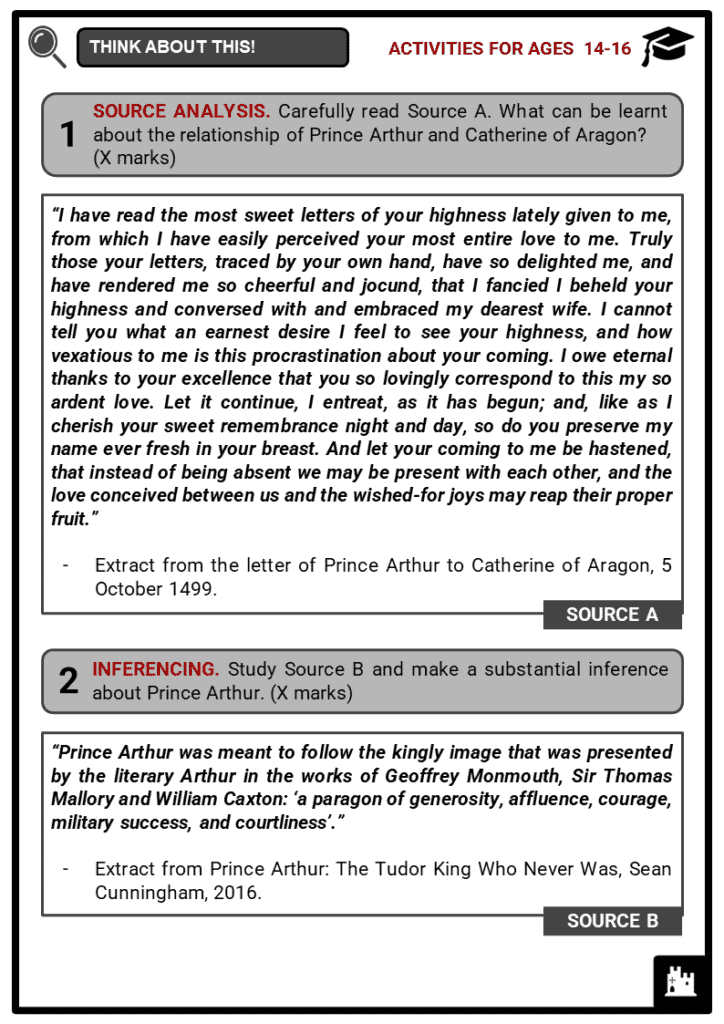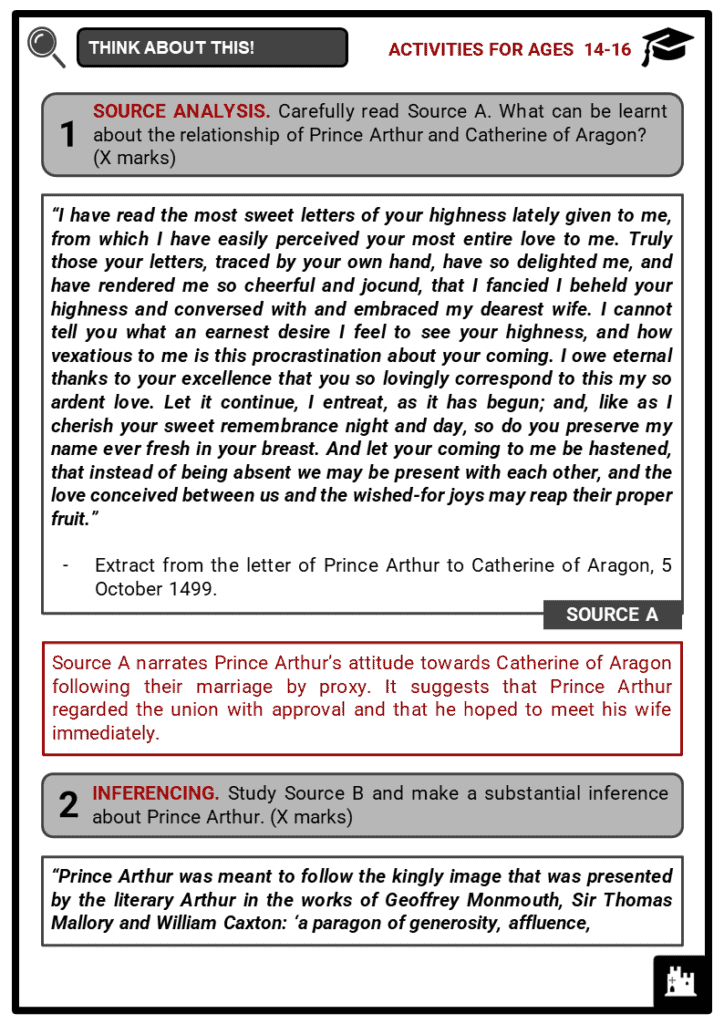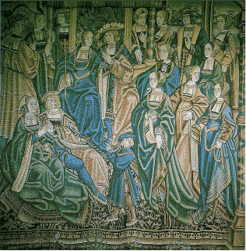Download Arthur Tudor, Prince of Wales Worksheets
Do you want to save dozens of hours in time? Get your evenings and weekends back? Be able to teach Arthur Tudor, Prince of Wales to your students?
Our worksheet bundle includes a fact file and printable worksheets and student activities. Perfect for both the classroom and homeschooling!
Table of Contents
Add a header to begin generating the table of contents
Summary
- Marriage of Henry VII and Elizabeth of York
- Birth and childhood
- Marriage and death
Key Facts And Information
Let’s know more about Arthur Tudor, Prince of Wales!
- Arthur Tudor, Prince of Wales, was the first child of Henry VII and Elizabeth of York. He represented the physical union of the Houses of York and of Lancaster following the culmination of the Wars of the Roses. As the heir apparent to the English throne, he received a well-rounded education and was given significant appointments in government. At 15 years old, he married Catherine of Aragon in 1501, a union that had been arranged since he was a child. Unfortunately, he died a year later after contracting an unknown illness.
Marriage of Henry VII and Elizabeth of York
- The years between 1455 and 1485 in England were characterised by five forceful changes of monarch. These dynastic struggles between the English monarchy and the nobility spanning three decades came to be known as the Wars of the Roses.
- At that time, the nobility of England was split into two groups that were centred on the descendants of Edward III: the Lancasters and the Yorks.
- As the Wars of the Roses drew to a close, Henry Tudor came to have the only surviving Lancastrian claim to the throne.
- Following his decisive victory at the Battle of Bosworth Field in 1485, he was proclaimed Henry VII on the battlefield.
- Henry VII attempted to establish the Tudor supremacy and unite the rival Houses of York and Lancaster.
- He married Elizabeth of York in January 1486, symbolising the union of the warring houses.
- Both Henry VII and Elizabeth of York had legitimate claim to the English throne.
- Henry VII’s claim was matrilineal and via an illegitimate line back to the third son of Edward III, John of Gaunt.
- Elizabeth of York, whose claim was through her father, Edward IV, did not seize the throne as queen regnant.
- The marriage of Henry VII and Elizabeth of York sought to strengthen the alliance of the Lancasters and Yorks, and prevent civil wars and rebellions that plagued the previous reigns.
- With the birth of their heir, this union and the Tudor dynasty would be further fortified.
Birth and childhood
- Born on 19/20 September 1486 in St. Swithun’s Priory, Arthur Tudor was the first child of Henry VII and Elizabeth of York. He was named after the legendary British hero known for fabulous exploits. He became the Duke of Cornwall at birth.
- He was baptised the Sunday after his birth in Winchester Cathedral, with John de Vere, Thomas Stanley, William FitzAlan, Queen Elizabeth Woodville and Cecily of York acting as his godparents.
- At a very young age, he was promised in marriage to Catherine of Aragon, the youngest daughter of Catholic monarchs Isabella I of Castile and Ferdinand II of Aragon.
- The marriage agreement was established in the 1489 Treaty of Medina del Campo, and its political significance lay in the strengthening of the relations between England and Spain, a useful alliance against France.
- What was the 1489 Treaty of Medina del Campo?
- It was signed in March 1489 between England and Spain with three main conditions:
- Spain and England would provide aid to each other should one declare war on France
- Reduction of tariffs between the two countries
- Arrangement of marriage between Henry VII’s heir, Arthur, and daughter of Isabella I of Castile and Ferdinand II of Aragon, Catherine
- At the age of three, Arthur was declared Prince of Wales and Earl of Chester after being made a Knight of the Bath.
- After he was made a Knight of the Garter in 1491, his formal education began.
- He received a well-rounded education under the instruction first of John Rede, then Bernard Andre and finally Thomas Linacre.
- His education focused on grammar, poetry, rhetoric, ethics and history.
- Aside from being a skilled pupil, he was interested in archery and dancing.
- When Henry VII travelled to France in 1492, Arthur was named Keeper of England and King’s Lieutenant.
- Continuing what Edward IV started, the Council of Wales and the Marches was established with the intention of imposing royal authority in the region.
- The Council was headed by Arthur’s great-uncle, Jasper Tudor, Earl of Bedford. He was not to be dispatched to Wales until 1501.
- In 1493, Arthur held the power to appoint Justices of Oyer of Terminer, and received an extensive land grant in the region.
Marriage and death
- Whilst the union of Arthur and Catherine was arranged as early as 1489, the marriage treaty was only finalised in 1496. It settled Catherine’s dowry at 200,000 crowns and the marriage would take place once the pair reached canonical age.
- Before the marriage by proxy occurred on 25 August 1497, a papal dispensation was first sought and issued due to Arthur’s age.
- The Spanish monarchs expressed concerns about sending Catherine to England whilst rival claimants to the English throne were not removed. Nevertheless, Catherine reached England in October 1501.
- Arthur and Catherine, who had been exchanging letters in Latin, met for the first time at Dogmersfield in Hampshire.
- It appeared that the pair received each other pleasantly. In fact, Arthur described his intention of being a loving husband to Catherine in a letter to the Spanish monarchs.
- On 14 November 1501, Arthur and Catherine married in St. Paul’s Cathedral.
- Arthur was only 15 years old, whereas his wife was 16 when she was walked down the aisle by Arthur’s brother, ten-year-old Henry.
- Henry Deane, Archbishop of Canterbury, officiated the ceremony.
- The wedding was a great, lavish celebration.
- Although Henry VII is known as the king that did not easily spend money, he was extravagant in the organisation of his heir apparent’s wedding.
- The pair headed for Baynard’s Castle, where they were welcomed, and the bedding ceremony was laid down.
- Following a month of residing at Tickenhill Manor, the consorts lived together in Ludlow castle to oversee the government in Wales.
- Although Ludlow castle was in Shropshire, the castle was the administrative centre of the government of Wales.
- At the time, the border was relatively peaceful after many centuries of warfare, hence Arthur found it manageable to supervise the region.
- Unfortunately, the newly-weds contracted an unknown illness in March 1502.
- Catherine managed to survive the sickness. However, Arthur died from it on 2 April that same year.
- Two days later, when news of Arthur’s death reached the king's court, Henry VII and Queen Elizabeth were grief-stricken.
- On 25 April, Arthur’s body was taken from the Parish Church of Ludlow via the River Severn to Worcester Cathedral, where he was buried.
- Following Arthur’s death, Catherine of Aragon moved to London and lived for a period of time with Elizabeth of York, her mother-in-law.
- Arthur’s younger brother, Henry Tudor, became the first in line to the English throne.
Image sources:
- https://upload.wikimedia.org/wikipedia/commons/6/69/Anglo-Flemish_School%2C_Arthur%2C_Prince_of_Wales_%28Granard_portrait%29_-004.jpg
- https://www.britishbattles.com/wp-content/uploads/2019/08/Battle-of-Bosworth-Field.jpg
- https://upload.wikimedia.org/wikipedia/commons/d/dc/ArthurCatherine.jpg

